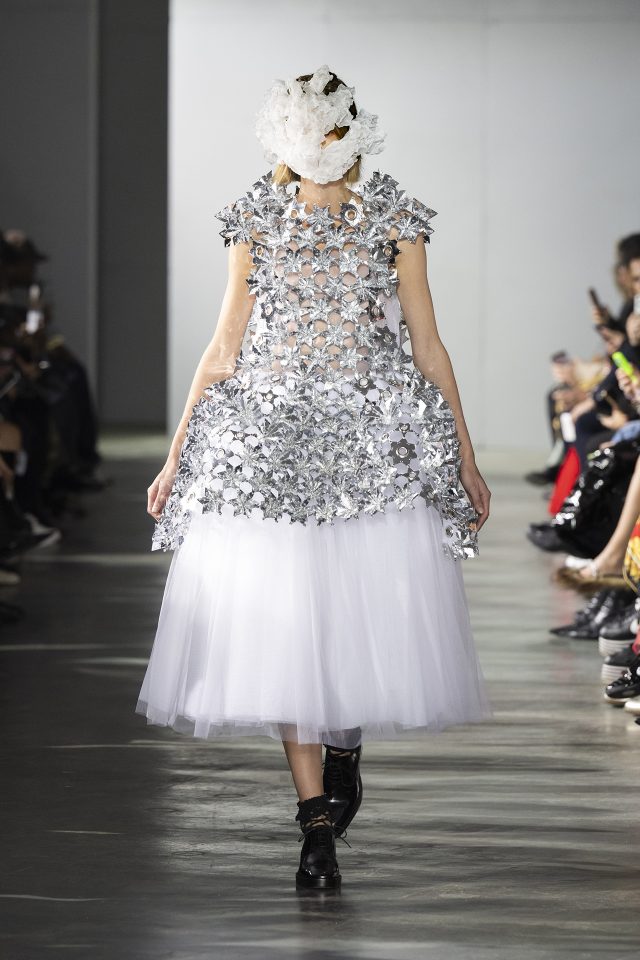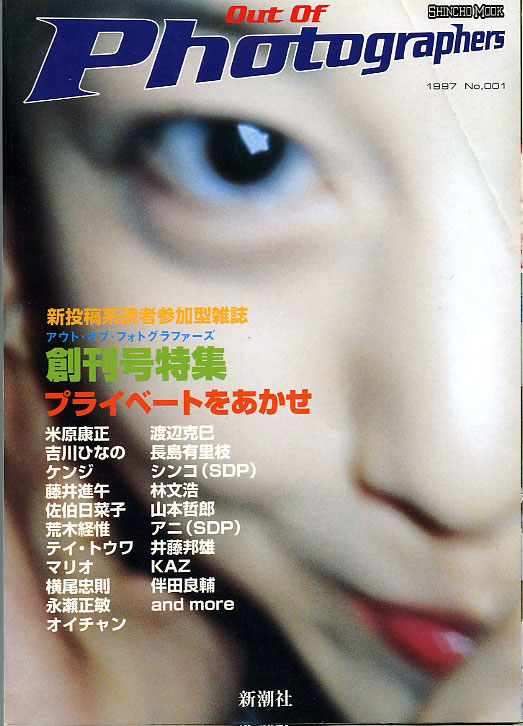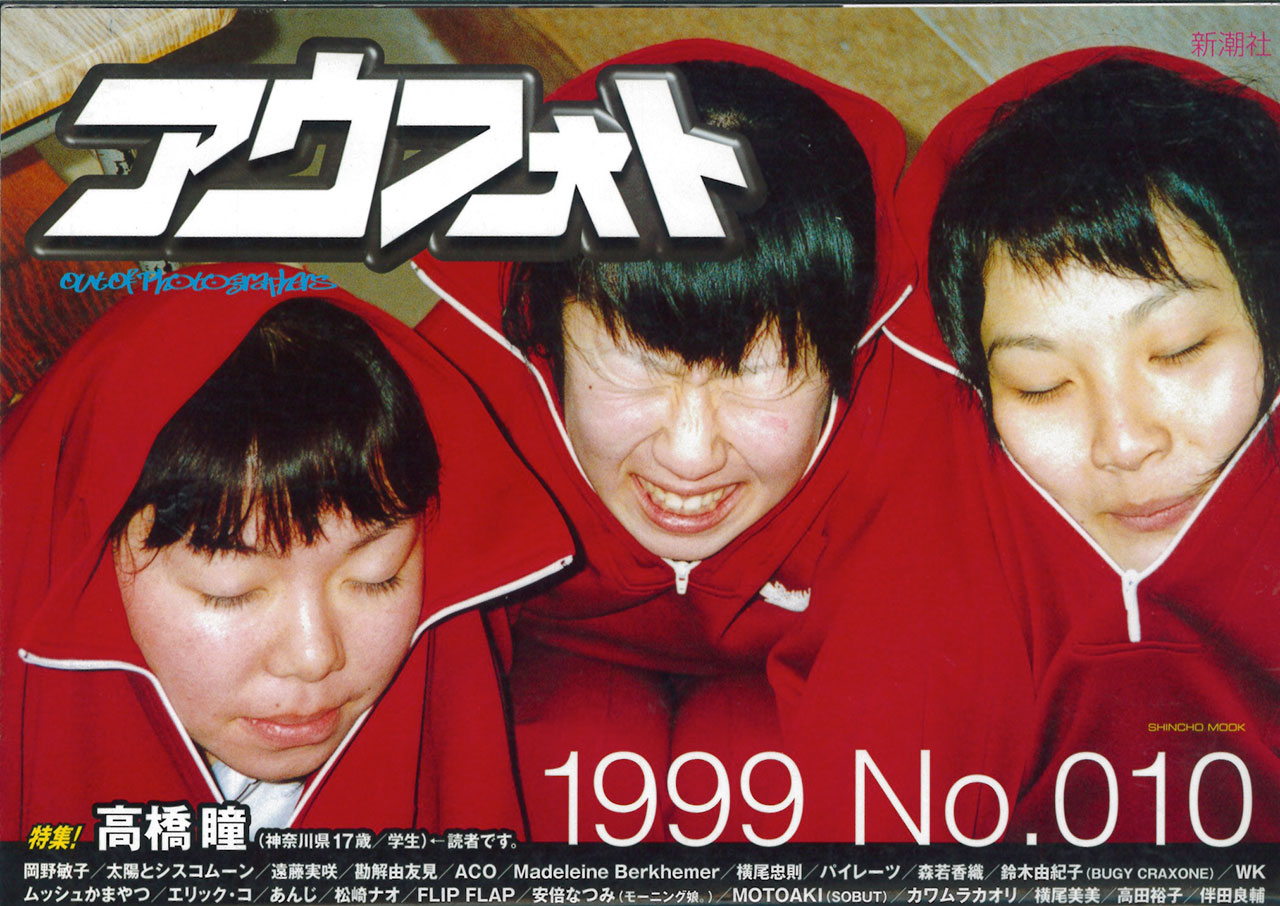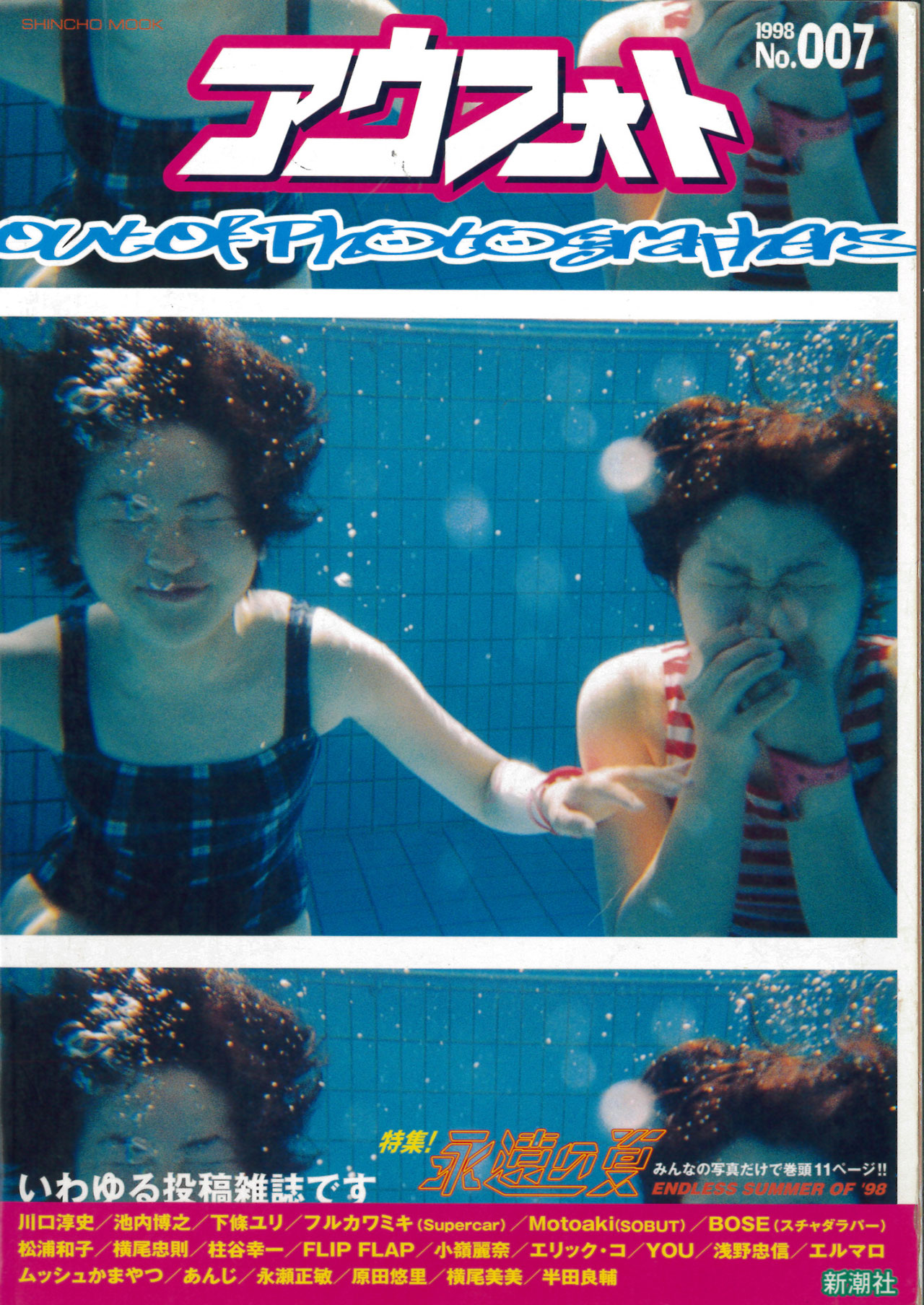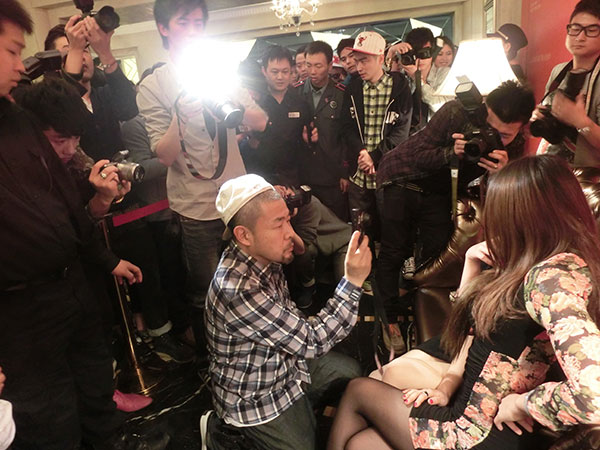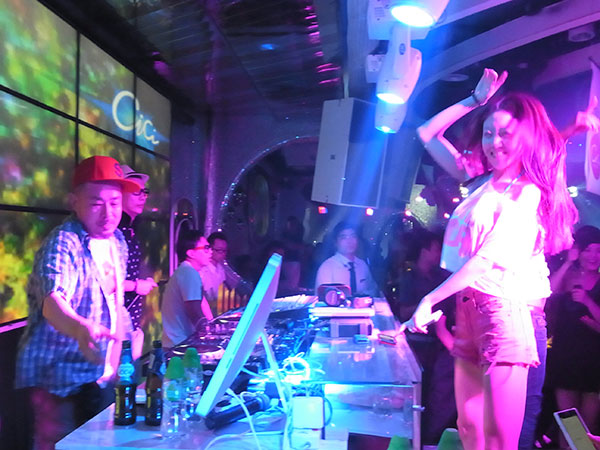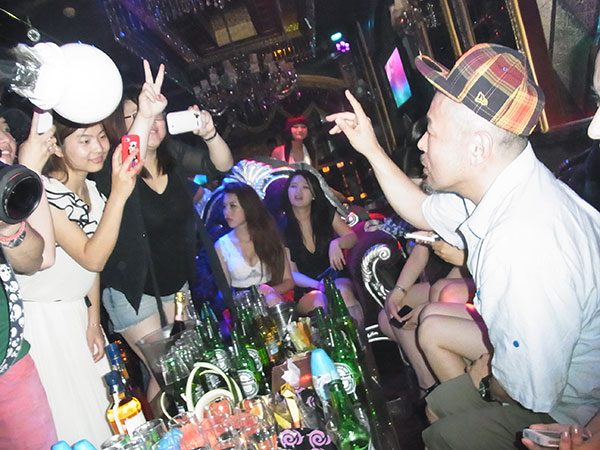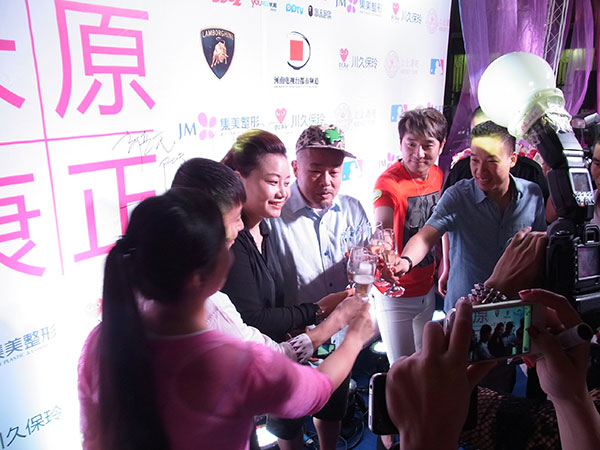写真家・米原康正インタビュー
Yasumasa Yonehara
東京ガールズカルチャーの仕掛け人“ヨネちゃん”こと米原康正のロングインタビュー。
写真家・米原康正インタビュー
Photography
*You’ll find the English text after the Japanese.

Photo by Hidemasa Miyake | © The Fashion Post
“ヨネちゃん”こと米原康正は、インスタントカメラ「チェキ」を使うフォトグラファーのイメージが強いかもしれない。しかし、彼はかつて編集者として『egg (エッグ)』『アウフォト』『smart girls (スマートガールズ)』など、90年代以降の東京カルチャーシーンを象徴する雑誌を創刊してきた仕掛人でもある。つねに時代の最先端の女の子カルチャーを捉えてきた彼のキャリアは、そのまま東京カルチャーの変遷と言っても過言ではない。AKB48 の立ち上げ時はビジュアルのディレクションを担当し、現在はきゃりーぱみゅぱみゅをはじめとする原宿のカワイイカルチャーを世界に発信している立役者のひとりだ。早くからアジアでも活動の幅を広げ、中国版ツイッターの『新浪微博 (シンランウェイボー。以下 Weibo)』では87万人を超えるフォロワー (2013年1月現在) と日々交流を続けている。移り変わりが激しい東京の中で、つねにその現場感を掴んでいる彼は、どんなバックグラウンドから現在に至り、そしていまの日本になにを思うのか。インタビューの中で語ってもらった。
—まず米原さんのバックグラウンドから教えてください。
受験生のとき予備校の近くに住んでいる奥さんと不倫してたんだよ (笑)。それが親にバレて大学受験も失敗して、そのまま家出をして東京に出てきた。僕は地元ではヤンキーにもなれず、しかも受験生という納得できない立場ということもあって、とにかく閉塞感を感じていた。だからその不倫事件が飛び出せるキッカケになったんだよ。でも結局探しに来た友だちに簡単に発見された。ラッキーにも、ちゃんと受験をしたら大学受かって、そのまま東京に残れたという感じかな。
とにかく田舎のヤンキー文化が嫌いで。田舎だと周りと違うファッションをしているだけでヤンキー枠に入れられちゃうんだよね。僕が中学のころはグラムロックが流行っていたんだけど、その影響を受けてエナメルの細いベルトとかバギーパンツを履くと、それだけでヤンキー枠に入れられて先輩に呼び出されて交換されちゃう。僕はグラム枠でやっているつもりだったんだけどね。
だけど東京に出てきてからは、田舎のヤンキー文化からは自由になって、自分が好きなモノの話ができる友達もできるようになった。17歳のとき Sex Pistols (セックス・ピストルズ) が好きだったんだけど、田舎では CAROL (キャロル) 一色だったから話せる友達がいなかった。でも東京に出てきたら場所によっては全員 Pistols 好きだったりして。東京は人も多いし新しいモノを認める人たちがいっぱいいるんだなって感じたんだよね。それでもうここしかないと思って、これからは東京をちょっと極めようかなと。
東京では新しいことが生まれる場所で仕事をしたいと思っていたから、大学に通いながら集英社でバイトをしてて、最初は『週刊明星』という芸能雑誌のバイトしてたね。それから『週刊プレイボーイ』が若者のネタが欲しいということで、僕に声がかかって、「悪い夜の生活」みたいな街のニュースを集める取材をやってたの。当時バイト代で月30万円くらい稼げちゃって、調子良いとボーナスも含めて100万円もらえるときなんかもあった。大学生なのに車を持てたり、当時は本当にイケイケだった。
時代は1970年代後半でちょうどバブルの差し掛かり。大学入ったころの僕は、モテると思ってずっとパンク少年だった。でも全然モテなくて、周りの女の子に聞いたら「だってサーファーじゃないじゃん!」って言われて…周りを見渡すと時代は第2次サーフィン・ブーム。街中がみんなサーファーになっていて、フォルクスワーゲンのビートルの上にサーフボードを釘で打ち付けて走ってたりしてたね。丘サーファーってやつだよね。とにかくサーファーの格好をしていればモテる。そんな時代だったかな。そういう情報は田舎じゃぜんぜん入ってこないんだよね。東京ではパンクが流行っているに違いないと完全に勘違いしていたから。当時、パンクからニューウェーブに時代が移っていったときで、YMOとかが出はじめたころ。だから僕は「まことちゃんカット」みたいなおかっぱ頭にしていたんだけど、おかっぱを伸ばすとサーファーの髪型になるから、サーファーになるのはそんなにむずかしくなかったんだよね(笑)。それでサーフィン部に入り、サーフィン人生を送り出したって感じ。

Photo by Hidemasa Miyake | © The Fashion Post
そういうメジャーな波に乗る一方で、アンダーグラウンド・シーンにも出入りしていたけどね。でもサーファーの格好をしているからそのシーンでは僕の中身を直接知らない人にはすごく変な顔をされるんだよね。(笑)。メジャーもおもしろいし、アンダーグラウンドもおもしろいしというのがあったから、別にどっちが良い悪いとかではなくて、せっかく東京にいるんだったらぜんぶ知っていた方がいいと思ってさ。だけどそういう人は周りにはぜんぜんいなかった。そのときにひとつのことにどっぷり浸かるのではなくて、もっと東京の街全体や地球単位になって、なんでそのシーンがおもしろいのかをいろんなものを対象にして、って主に女の子だけだけど、考えていたのがいまの僕の仕事のベースになっていると思う。
ついでにその時代の話をすると、僕らの世代 (現在50歳前後) はちょうど大学サークルができはじめたころで、大学生パーティーなんかもやりはじめた世代。学生起業のはじまりでもあるし、マスコミや広告代理店が一番人気になりだしたのはちょうどそのころ。つまり他人のふんどしで楽をして稼ごうと考えはじめた世代だよね。そういう世代がいまの世の中を仕切っていたりするからもう絶対に良くないよね、いまの日本って (笑)。
雑誌『egg』『アウフォト』『smart girls』誕生エピソード

『smart girls』
話を戻すと、そのころずっと出版社でライターの仕事をしていたんだけど、出版社の編集者が書けという文章にどうしてもずっと納得できなかった。「こういう男がモテる!」という文章を書けと言われても、どう考えてもそんな文章を読んでいるような男がモテるわけがないと思って。そうなったらもう自分が編集者になるしかないと思って編集的な仕事をやりだした。でも、それも編集長の意思で思い通りにならなかったけど。
その当時のあるエピソードがあって、僕はある雑誌で後藤久美子のインタビューを担当してた。でも、とにかくしゃべってくれないんだよね。大人を冷静な目で見て「うん」か無言しか無い。インタビューとしては最悪だけど、彼女のひととなりを伝えるにこれ以上のリアルは無い。だから、僕はそれがやたらおもしろく感じてさ、原稿には「うん」しか書かなかったんだよね。そしたら編集長に「お前が質問したことに後藤久美子が『うん』って言ったなら、それを後藤久美子がしゃべったように書け!」って怒られた。その時から、僕はそんなのやっちゃだめだと思ってたね。なんか出版社のそういうリアルじゃないことに僕は納得がいかなかった。

『egg』創刊準備号
そうなるともう自分で本をまるごと一冊作るしかないと思って、できたのが『egg』。ミリオン出版というところから創刊されたんだけど、当時はエッチな本の出版社的な印象が強かったかな。そこの編集者に、本を一冊作るのにおもしろいネタがないかって相談されてさ。僕は1993年くらいからコギャル文化に注目していて、既にコギャルを扱った企画をいろいろなメディアに出していたのね。それでそういうコギャルの女の子たちが出たくなるような雑誌を作ろうと企画して『egg』ができたんだよね。
それがはじめて文章から写真までぜんぶ僕が選べて書けた雑誌。そこからは基本的に仕事を依頼されても自分で企画を考えられるモノしかやらないというスタンス。1995年に『egg』の0号が創刊して1997年から月刊誌がはじまった。ところが『egg』が売れだして、編集方針でどういう女の子を使っていくかという話になったとき、僕は「『egg』ってなんだよ」とか言っちゃうような女の子。お願いしてもなかなか出てくれないような、そんな子にこそ出てほしかった。だけど出版社の人間は、自分から取材されたがるような子を使いたがるんだよね。いまでも出版社というのはそうなんだけど、お金がかからず楽な方を取材したがる。僕からするとそんな子を載せてしまったら『egg』の本来の意味が失われると思っていたし、なんで女の子たちがこの雑誌に出たかったかというと、それは『egg』がそういうこだわりを守ってきたから。そこは編集部として守り続けないといけないって言ったんだけど、自分たちの意見が通らないと分かった途端に出版社というのは「これは私たちの雑誌です」って言ってきたんだよね。それで僕は『egg』を辞めることになった。
それで新しくはじめたのが新潮社の『アウフォト』という雑誌。egg作ってる時からそれは始まってたんだけど、ちょうどそのとき女子の写真ブームで、みんなが富士フイルムの“写ルンです”で写真を撮っていた。コギャルと呼ばれていた女子達がポラロイドで撮った写真に自分で絵を描いたりして、それを壁に貼るみたいな文化が生まれていて、それがある種のポップアートみたいになっていた時代。それを高校生だけじゃなくて全国からいろいろな人の写真が集まったらおもしろいなぁと思って作ったのが『アウフォト』。故林文浩氏の『DUNE』の仕事で仲良くなったTerry Richardson (テリー・リチャードソン)にも、3号目ぐらいから写真出してもらったりした。それは3年半続いて自由にやらせてもらいました。
そして2002年に作ったのが『smart girls (スマートガールズ) 』。当時、裏原系女子がブームで、『mini (ミニ) 』が75万部も売れていた。僕はそのとき、雑誌に出てくる裏原の女の子たちにはセックスアピールがぜんぜんなかったけど、彼女達にエロいテイストをプラスさせたイメージを作るってことを、時代も本人達も待っているって確信があった。僕の対象はいつも女子に受ける女子。女子受けを狙って作ったちょっとエッチな雑誌、それが『smart girls』だった。『smart girls』を出したら海外からの反響がすごかった。

『smart girls』創刊号
日本に来る海外アーティストは、みんな『smart girls』に引っかかってくれて、それで海外の展示会などに招待されることも増えていったんだよね。『smart girls』の裸を見せていないというコンセプトがよかったみたいで、中華圏の人たちからの反響が大きかった。それがいまの僕の中華圏の人気にもつながっているよね、絶対。
だけど『smart girls』が売れだしたら、出版社がまたもや「『smart girls』は私たちの雑誌」という話になって、またしても抜けること…キツいよね、日本の出版社って。でもそれがキッカケで、写真はぜんぶ自分で撮るようになった。写真が撮れると本はぜんぶ自分でできるからね。それで現在は、編集者よりフォトグラファー方のイメージが強い感じがするのかな。
—その後、アジアにも進出していくんですね。
2007年にほしのあきちゃんの『SNEAKER LOVER (スニーカー・ラバー) 』という本を香港で撮影したんだけど、いまや中華圏の王道パターンになっている「スニーカー×ビキニの女の子」というのは実はこれが原型なの。日本に戻って写真集を発売したら台湾から展覧会をやってほしいという話が来て、2008年に台湾で展覧会をやった。それが初めて中華圏でやった展覧会。そこからいろいろな話がきて、香港・上海などでも開催して、それからはもう中国には行きっぱなしだね。中華圏で人気があるけど実体がまだ掴めてなかった女の子たちを僕が最初に連れていくという役割を担っている部分はあると思う。逆に言うと中華圏では、僕が連れていく日本の女の子は人気者になるというイメージにもなってきている。
—蒼井そらさんを最初に中国に連れて行ったのも米原さんだと聞いています。
そうだね。そらちゃんを中国に連れていったのもそのころ。2009年にイタリアの自動車メーカーのLamborghini (ランボルギーニ) 上海支店のパーティーが、僕をスペシャルゲストとして招いて行われたんだけど、ゲストで日本から女の子を呼びたいという話になったの。日本には伝わってなかったけど、当時からそらちゃんは中国のAVブームの中でダントツの人気だった。男子全員が「蒼井そら!」って名前で興奮するぐらい。だから連れていった。そのときの盛り上がりは本当にすごかったね。そしてそらちゃんがすごいのは、上海行った後すぐ『Weibo』をはじめているところ。その1年後に始めた僕なんかはまだ『Weibo』を2年半くらいのキャリアです。はじめてそらちゃんに『Weibo』を見せてもらったときでも既に30万人くらいのフォロワーがいてびっくりしたのを覚えている。見るたびにどんどん増えていって、いまや1353万人 (2012年11月現在) もフォロワーがいるからね。だれに教えてもらったのかはわからないけど、当時から『Weibo』をやりはじめること自体もすごいし、あの人はぜんぶ自分で投稿しているからさらにすごい。日本の芸能人とかは『Twitter』で書いたものをスタッフに中国語に書かせて投稿しているだけだったりする。でも中国の常識として、weiboはほとんど本人がやってるものなんだよね。そうすると、そらちゃんはきちんと中国人のやり方に従ってるってことになるんだ。そういうところがやっぱり響いたんだと思う。もう簡単な中国語だったらしゃべれるって言っていたし。いま一部の反日の人たちの間である言葉が流行ってて「釣魚島但是中国的、蒼井空才是世界的!(釣魚島は中国のモノ、蒼井そらは世界のモノ!)」。だからそらちゃんだけは中国人に怒られないんだよ(笑)。
外国人コンプレックスから脱却できない日本人と中国文化のリアル
—日本と中国の状況を見てきて感じていることを教えてください。
日本人は中国をなんとなく見下している人たちが多いよね。でも2006年ぐらいから日本では韓流ブームがはじまりだして、2008年にはH&Mとか外資も入りだした。そして日本のほとんどメディアには自国のニュースがあまり載らなくなるという状況が続きだしたよね。そう考えたときに、「日本人は本当に中国をバカにできるのか?」と思った。だって実際に中国に行きだしたら「あれ、もしかしたら日本負けてないか?」と思うことがすごく多くて。それを日本に帰ってきてみんなに伝えても、言えば言うほどオシャレな人たちは僕から去っていってさ。いまでこそみんな中国とか言い出したけど。2008年とか「最近、中国行きだしている」と言っても都落ちみたいに見られたしね。僕からするともう東京はダメだから中国に行ってるだけなんだけど。実際に中国に行ってみなよって話だもん。そんな考え方一発でなくなっちゃうから。
中国とかアジアの状況を知ったうえで、「それでも東京で頑張ろう!」と言うのはわかるんだけど、単に過去の栄光だけで「東京はすごいぞ!」って言ってもだめ。やっぱり東京がいままで世界に対して威張れたのは経済が本当に良かったから。その経済がこんなに悪くなっているのに、いまだに経済が悪くなったことを認めようとしない。なおかつ中国の経済が良いということも認めようとしない。認めないってことは、その改善の仕方は永遠に分からないってことに気づいてない。いや、気づかないふりをしてるだけなのかもしれないね。
いまの中国もそうだけど内需が良いから目立つ国になれるわけじゃないですか。でも内需が悪いからって、自国を守るために韓国みたいに外にいけば、世界中と戦わなきゃいけなくなる。だけど、それは当然のことなんだよね。日本も外需を取りにいかなきゃいけない状況なのに、内需のやり方そのままで外需を取りにいこうとして失敗ばかりしている。
僕は日本のことが大好きだから、まず日本がこの悪い状況を認識しないとなにも生まれてこないと思ってるのね。ファッションを例にとると、日本人の内需というのはつねに「外人コンプレックス」のもとで成り立っていた。だからポスターや雑誌を見ても全部外国人のモデル。だけどそれを作っている人たちはだれも英語を話せなかったりするんだよね。いままで内需が良かったからそれでも良かったと思う。でもこれから中国とかに外需を取りにいかないといけない状況の中で、同じようなやり方でモデルを選び、外国人コンプレックスの日本の広告を持っていってもなにも響かないと思う。なぜなら中国人にはぜんぜん外国人コンプレックスがないから。中国の『Vogue (ヴォーグ)』にしても他の雑誌にしても、表紙は全部中国人だしね。白人モデルがたくさんいる中で、つねにセンターをぜったい中国人にするよね。ところが日本は中途半端に白人を使う。北欧とか言いながら、日本人はウクライナ出身とか東欧系のモデルを使っちゃったりする。東欧系なんて共産圏同士だし地理的にも近いので中国人のほうが良く知っているわけ。そういうのを日本人はぜんぜんわからないで白人は全員アメリカ人に見えちゃったりしてるのに、外人に憧れる(笑)。

『egg』
そういうのに疑問があるから、僕としては地に足がついたことをやりたいっていう思いがずっとあった。それはもう『egg』作っているころからそうだった。遠いとこのことより、自分の周りで生まれたことだったら「これがカッコいい!これはダサい!」とわかってはっきり言えるしね。僕もNYのことは好きだけど、NY生まれの外人に向かってNYの自慢をしても「は?」と言われるだけだしね。だったら東京のことを語らないといけないと思ったんだ。日本のオシャレな人たちってみんな日本のことは知らないのに、パリのこととかNYのことは詳しかったりするんだよね。「東京コレクションは?」と聞くと、「あんなのはダメだよ」とか言って盛り上げようという気持ちがないんだよ。別に僕は東京コレクションという存在には否定的じゃない。目的無くそれに関わってる人たちが多い状況が良くないと思ってるだけだ。
昔からファッション好きの人たちと仕事をしていておかしいと思っていたのは、「わぁ、ここNYみたい!」とか「ここロンドンみたくない?」とか言いながら仕事しているクリエイターたちが多いってこと。別に原宿の街並みだってカッコいい写真を撮れるわけですよ。それは街をどれだけ肯定的に見れるか、ってプロの能力なわけなんだよね。ところが今は世間で思われているカッコいいというイメージに、みんなが乗っかろうとする。僕はこれを「乗っかり文化」って言ってるけど、クリエイティブサイドが雰囲気に乗っかるだけで新しいモノを創ってない。それっぽいモデル、それっぽい写真を撮るカメラマン、それっぽい洋服を集めるスタイリストに、それっぽいヘアメイク。全部「それっぽい」だけ。そこにはなにも「自分がこういうことしたい」とか「こういうところをカッコ良くしたい」という意識が欠けている。そういうところとは関わりたくないなと思っているけど、やっぱり念が通じるんだろうね。向こうから関わらなくなるようになってきた(笑)。
—日本人の良いところはありますか?
でも逆に日本人のすごいところは、それをやり出したら NY の人よりも NY っぽくなったりするところ。日本人のそういうカメレオン体質は海外からすると脅威なのかなという気もする。いますごく批判的に言っているけど、意識してやったら日本人ほどこんなに NY のこと詳しい外人はいないわけだし、パリのことをパリの人よりも知っているからね。僕なんかも熊本から出て来たときは、東京の人間よりも東京のことを知っていたりしたわけだし。日本否定や劣等感からはじまるんじゃなくて、もうちょっと作戦としてそういう特徴を使っていけばいいと思う。だから僕もその日本人の特色使って中国人よりも中国のことを詳しい日本人になろうと思ってる。女の子のことに関しては中国人が好きな女の子はだいたい最初から分かってました。。だから、ほしのあき、蒼井そら、藤井リナを連れて行ったのも狙ってやったことなんですよ。中国の人たちに「ヨネちゃんが連れて来た女の子はぜんぶ衝撃だ!」と言われてますかね、実際。
日本人が手放してしまった「ギャルカルチャー」と「裏原カルチャー」
—アジア圏と比べて日本のカルチャーはどう見えていますか?
エンターテイメントは確実に日本人のイメージはなくなって、もうぜんぶ韓国だね。いま話題の K-POP、PSY(サイ)の「江南スタイル」は韓国語で歌ってビルボード1位だからちょっとやばいよね。『Youtube (ユーチューブ)』の再生回数では7億回を超えて(2012年11月現在)、Lady Gaga (レディー・ガガ) もすでに抜いちゃったし。それに音もすごく良くできている。うまいと思ったのが、江南は韓国で一番お金持ちなエリアなんだけど、サビの後にはきちんと江南スタイルの洋服が映し出されるようになっている。いま中国でも、洋服はメイド・イン・コリアが大進出中なんだよね。
この間、上海で開催された TGC (ティー・ジー・シー)では、トリが BIG BANG (ビッグ・バン) で、洋服の半分は韓国製。モデルの3分の1も韓国人。日本発の TGC はもう完全に韓国に乗っ取られちゃった。さらにここ2~3年で香港の日本に対する興味は一気に消えていっている。しかも「ギャルカルチャー」とか「裏原カルチャー」というのが「日本発」というよりも「中華発」のイメージになっているんだよ。だから裏原系の格好をして中華圏を歩いていたら台湾人か香港人にしか見られない。日本人はもうそんな格好しないんだもん。それは本来、元祖の日本勢がやらなきゃいけないこと。そして海外から見られたときに、日本人はもうなんのイメージもなくなってきちゃっている。日本人のイメージとか全部もう中華圏か韓国に取って代わられているという事実を日本人は早く知らないとね。そういう状況を日本のファッション・メディアがぜんぜん伝えないこと自体が終わっていると思う。そんなのジャーナリズムじゃないよ。
—日本のファッション・メディアについてはどう思いますか?
もうただのご用利きだよね。お金貰えるところで全部動くから。どこの媒体もその本来のことをやっていれば問題ないんだけど、全部お金で動いている。いままでハイファッションをやっていたメディアが全部ギャルに移って、誌面ではハイファッションの格好をしてお金はすべてギャルブランドからもらうみたいな構造。本当におかしいと思う。ハイファッションのメディアがギャル系と組んでいること自体が自分たちの否定だから成り立つわけがない。別にギャル文化を取り上げることはいいんだけど、いままで散々とギャル文化を否定しときながら、お金を出してくれるからという理由でコロって変わっちゃったんだよね。とか言うとまた僕の仕事がなくなっていくんだけどね(笑)。

Photo by Hidemasa Miyake | © The Fashion Post
—日本のファッション業界についてもなにか思うことがあれば教えてください。
これはだれも言わないから言っておくけど、日本のファッション業界はヤンキー的気質の人が多すぎる。それが何を意味するかっていうと、とにかく流行っているもの大好きってこと。中でも、芸能人、外国人大好き。いまのプレスは「ジャニーズきたー!」みたいな感じだよね。売れるまでは目茶苦茶に言っているくせに、その子が人気者になった途端に「ヨネちゃんぜひ連れて来てください!」って平気で言ってくる。本当にコロッて変わるよね。そういう変わり方がファッションといえばファッションなんだろうけど…。ヤンキー気質がファッション界の常識になってる。
—今後、日本のファッション業界はどうして行けばいいでしょうか?
日本ってみんなが同じ真ん中に集まってくる類いまれな社会主義な体質を持った国なんだよ。普通の国は金持ちと貧乏人がハッキリと別れるから、そこには2つの文化というか相容れない価値観が絶対に存在する。だけど日本は金持ちも貧乏人もLouis Vuitton (ルイ・ヴィトン) を欲しがるわけじゃないですか。ハイブランドをすべての真ん中に持ってくるという類まれなる国だと思うの。それが大成功した秘訣は内需がすごく良かったからなんだけどね。だけど、いまみたいに内需が悪くなってしまったら金持ちと貧乏人がはっきり別れるからそのやり方はぜったいに通用しない。だからやり方自体をもっと考え直さないと。貧乏な人は貧乏な人に合わせた服作りだし、お金持ちはお金持ちに合わせた服作りだし、そこは文化が違うということを認識しないといけない。日本人は日教組によって「みんなで手をつないでゴールしましょう」とか「競争は悪いこと」って教えられてきちゃったわけじゃないですか。そんなのもうありえない。世界に勝負するんだったら周りは競争意識バリバリで勝負してくるわけだから。日本人は世界が自分たちに合わせてくれると思っているからね。まあ、それもすり込みなんだけど。
—日本のブランドが中国をはじめ海外で勝負していくためには?
決して中国に媚びろと言っているわけじゃないけど、自分たちのスタイルをどう向こうの常識に合わせて相手の言語で伝えていくかが大事。そしてなんで日本が世界に評価をされていたかっていう原点に戻らないといけないと思う。先述したように2006年以降の日本は世界に評価されるモノはぜんぜん生み出せていない。彼らが日本のどの部分が好きだったのかというと、日本人の感覚なわけ。いまの僕たちじゃない、以前の日本人。早く、外人の友だちもいないのに外人モデルを使えばカッコいいと思っていることを疑問に思わないと。別に外人の友達がいなきゃいけないって言ってるわけじゃないよ。つまりテレビとか漫画しか見てないのに、突然仕事になったら今年のパリやNYのトレンドしか興味ないふりするのはやめようよって話。別に1960年代に戻れというわけじゃなくて、少なくとも家に帰ったらロックぐらい聞こうよという提案。そういう人たちって歌謡曲本当に大好きだったりするのに、それを見せようとしない。本当はそういう人たちが歌謡曲ではじまる文化を自分たちで構築できれば、よっぽどカッコ良いものができると思う。よくクリエイターの事務所には外人のポスターや洋書ばかり置いてあるんだけど、彼らは読んだり見たりはしないんだよね。ただパラパラ見て「あぁこれカッコ良いね」と印をつけるだけ。そして家に帰るとテレビと漫画しか見ないの。みんなサラリーマンなんだよ。サラリーマンがオンとオフを切り替えるように、アパレルのおじさんたちがファッションの仕事をしているときはゲイっぽいフリをして、仕事が終わったら「さあ、キャバクラ行きますか!」とやっているのを見るたびに驚いちゃう。オンとオフをやっぱりひとつにしないと。日本以外の国は全部ひとつだと思う。家に帰ってもゲイの人はゲイなんだよね。女の子と会っているときだけゲイっぽいフリをして、仕事終われば男って、やっぱおかしいと思うもん。男だけになると応援団、みたいな感覚持った人たちがあまりにも多くファッション業界に関わっている気がする。僕はとくにファッションとかカルチャーに関わる人は、公私全て一緒じゃないといけないと思っている派なんです。

米原康正の『Weibo』
—『Weibo』についてヨネちゃんが可能性を感じている点があれば教えてください。
中国で僕のことを知っている人は、主に80后、90后と呼ばれる若い人たち、その中でも新しい人たちだと思うんだ。その新しい人たちがいまなにを考えていて、どういうものが好きなのかというのが、マーケティング的に全部わかるのがすごいと思う。『Weibo』はいまどの言葉が流行っているのか、ベスト100くらいまで出るんだよね。そういう意味で中国を理解すための辞書みたいなモノ。尖閣問題のときも日本のテレビを見ると中国人が全員「日本に帰れ!」って言っているようにしか見えないけど、『Weibo』を見たら「ヨネちゃん大丈夫ですか?ごめんなさい、中国人暴れちゃって…」ってかなりの数の中国人が言っていた。地に足がついた中国というものをインターネットで理解できるから、それを見ないこと自体がもったいないと思う。『Weibo』だけじゃなくて、台湾とか香港の人たちって『Facebook』をすごく上手に使っているよね。向こうはいろいろな人たちとつながるためにSNSを使うんだけど、日本人の使い方は『mixi (ミクシー)』的な使い方で、知っている人たちだけのコミュニティにしたがる。でもそこは日本人が外に広がらないで中にこもるように、意識的に日本の教育にそうさせられてきたと思うんだけどね。“自分撮り”とかも中国、台湾、香港の人たちの方が得意だもんね。中国人の女の子たちの自分アピールはすごいからね。
—日本では自分アピールは良く思われない風潮がありますよね。
自分たちの個性をアピールして人に認められてなんぼのワールドワイドな世の中に生きているのに、日本のヤンキー文化は出る釘は打たれて強い人しか出てこられないようにしているね。しかもその強い人というのは、個性が強いとかじゃなくて、腕力的にキャラとして強い人しか出てこない。日本は本当に才能がある人たちを全部潰している気がしてならない。本当は内にこもっている人ほどスゴいモノを作れたりするけど、そのヤンキー文化でそういう人たちはいじめられやすい。本来オタクというのは物事をすごく追求していて、ひとつのモノに詳しい人間のことを指すと思うんだけど、それがいつからか「お金を使う人」という定義に書き換えられちゃった。例えばうるさ型のマスターがやっているような街のコーヒー専門店とかは、海外の人たちはすごく認めている。実はあんな手間暇がかかることをやっているのは日本だけだからね。本来ファッションというのも、その国の歴史があって、文化があって、そしてブランドがある。という流れがはずなのに、日本のファッションをやっている人たちは「なんのために洋服を着るのか?」とか「なんのためにオシャレをするのか?」という本質がないまま、いまこれが流行っているということだけを追っかけているからおかしい。例えば HYSTERIC GLAMOUR (ヒステリックグラマー) はワールドワイドにロックの流れを形にしてくれたブランドなわけじゃないですか。本来ファッションジャーナリズムが大切にしなきゃいけないのは、そういうイメージをきちんと守り続けているブランドやショップだよ。きちんとストーリーがあるところを、ストーリーとして語ってあげて、そこで人がモノを買うようにしていかなきゃいけない。メディアサイドがそういうストーリーを面倒くさがっているんだよね。
「原宿カワイイカルチャー」を世界に向けて発信する理由

きゃりーぱみゅぱみゅ
—最後に、青文字系や原宿カワイイのカルチャーについて、今後どう関わっていく予定ですか?
海外をいろいろ回っていてすごく考えるのが、先述したように「日本っぽさ」とか「裏原っぽさ」みたいな部分がもう書き換えられていること。ギャル系の可愛さみたいな部分はもう中国の子たちの文化になっちゃっているし、そこには日本のギャル系のかわいさはなくなっちゃっている。
そう考えたときに、もしかすると原宿的な「カワイイ」というのはマネできないのでは?と思って。本来、日本人の体が小さいというのは劣等感だったりするわけだけど、あの原宿的な「カワイイ」は日本人の身体的な特徴を最大限にいかしたスタイルだよね。僕は自分の似合うことを最大限にいかすことがファッションだと思っているから、日本の女の子のかわいさをいかすことで日本ファッションとして世界に勝負していくことができると思ってる。そしてこれからは世界に向けて日本人の「カワイイ」を大プレゼンしていくことが必要なのではと。そこには全力をあげて関わっていこうって思っていて、これがなくなると僕はちょっと自信ない…このカルチャーを海外にとられちゃうと、後ろにもうなにも控えてない気がするので。だからこれをとられちゃったら日本は終わっちゃうくらいの危機感を持ちつつやっている。韓国が「江南スタイル」ならこっちは「カワイイ・スタイル」で!
でも日本人は極端だから、「カワイイ」が流行ったらもう全部「カワイイ」。「セクシー」が流行ったら全部「セクシー」みたいに流れちゃう。でも似合う人は似合う人のまま残っていればいいと思う。「カワイイ」の似合わない人まで「カワイイ」をやりだすと、「セクシー」が終わっちゃったみたいに、そこで「カワイイ」が終わっちゃうから。だからちょっと分類していく作業が必要だね。「カワイイ・カルチャー」と「セクシー・カルチャー」というのは決して一緒のモノを好きな人たちじゃなくても良いわけなので。だから逆に「セクシーも残さないと!」という動きもしようとしている。
日本は「一緒のモノを好きじゃないと友達じゃない」みたいな考え方があるけど、価値観が違ったって友達になれるということをそろそろはじめないと。日本は価値観が違うということを否定ポイントにしちゃうけど、そこは決して争うポイントではない。だから日本人も中国人も友達になれるんだよ。こんな貧富の差が激しくなっているのにみんなの価値観が真ん中に集まったフリをしているイメージで日本は動かされているから、そこをひとつずつ解決していかないといまの状況は変わらないような気もする。いろんな価値観があって、いろんなモノが共存して成り立っている世の中というのが僕の理想なんだよね。
<プロフィール>
米原康正 (よねはらやすまさ)
編集者、クリエイティブディレクター、フォトグラファー、DJ
世界で唯一チェキをメイン機材とするアーティストとして、雑誌、CDジャケット、ファッションカタログなどで幅広く活躍。中華圏での人気が高く、中国版Twitterである「新浪微博」でのフォロワーが71万人超、シューティングとDJをセットにしたイベントでアジアを賑わせている。世界のストリート・シーンで注目される、ジャパニーズ・カルチャーを作品だけでなく自分の言葉で語れる日本人アーティストの一人。

Photo by Hidemasa Miyake | © The Fashion Post
Yasumasa Yonehara, or “Yone-chan” (as he is commonly referred to), is usually recognised as the photographer famous for using the Cheki instant camera. However, he was once the creator and editor of magazines which embodied the Tokyo 90s cultural scene, such as ‘egg’, ‘auphoto’ and ‘smart girls’. It’s not an exaggeration to say that his career, always seeking out the pioneers of female expression, resulted in genuinely changing Tokyo culture. Working as Visual Director during the launch of AKB48, and currently working with Kyary Pamyu Pamyu, Yonehara promotes Harajuku’s ‘kawaii’ culture to the wider world. He has been active throughout Asia from the start and likes to mingle with fans on a daily basis. His Chinese Twitter account, ‘新浪微博’ (‘Shinranwiebo’), has over 700,000 followers as of November 2012. Yonehara always has an expert grasp on the state of Tokyo’s ever-changing cultural scene. The Fashion Post asked him about his background and his current thoughts on Japan.
—Please tell us about your background.
While I was meant to be preparing for my college entrance exams, I was having an affair with a woman who lived near my school. My parents found out, I failed my tests, and I subsequently left my house and moved to Tokyo. I wasn’t really a delinquent back in my hometown; I just didn’t have a grasp on how to prepare for entrance exams. I also felt this strong sense of hopelessness. The ordeal over my affair became my chance to get out. However, friends who came looking managed to find me easily enough. I guess I was lucky; I eventually passed the tests, made it into college, and stayed in Tokyo. However, I hated the defective culture of the countryside. In the countryside, you’re seen as inferior if even your fashion is different from everyone else’s. In Junior High, I was influenced by the popular glam rock scene, but just putting on a skinny animal-print belt or baggy pants made me an outcast. I was called out by my seniors and made to change, even though I was just trying to mimic the glam rock look. When I came to Tokyo, I was freed from this culture and I made some friends I could talk to about the things I liked. When I was 17, I was into the Sex Pistols, but in the countryside, everyone else was wrapped up in Carol. There was no one there that I could talk to about music. However, when I came to Tokyo, there were places where everybody else also liked the Sex Pistols. In Tokyo, there were so many people and so many people who could appreciate the new. It was then that I decided that, for me, there was only Tokyo and that was the only place I would settle in. I wanted to work in Tokyo and create new things, so while I was at college, I worked part-time at Shueisha Publishing Co. At first, I was working on the weekly tabloid, ‘Shuukan Myoujyou’. Because they were looking for young material, I was asked to do research for ‘Shuukan Playboy’ on town news under titles like ‘Life in the Bad Night’. At the time, I was making about 300,000 yen a month. If things were good, I could get a bonus of 1 million yen. Even though I was just a college student, I had my own car. It was a really exciting time for me.
This was in the second half of the 70s. When I entered college, I was a punk and I thought I was popular. In truth, I was actually quite unpopular. When I asked the girls around me about this, they said, “You’re not even a surfer!” I looked around and realized we were in the midst of the second Surfing Boom. Everyone had suddenly become a surfer and they were driving around in Volkswagen Beetles with surfboards nailed to the top. They only resembled surfers, but anyhow, so long as you looked like a surfer, you were automatically popular. It was that kind of time. That sort of information doesn’t make it to the countryside; I’d always thought punk was popular in Tokyo, but I was wrong. At that point, the scene was moving from punk to New Wave and YMO came out. Because of all this, I had a bobbed haircut like Makoto-chan. If you grew a bob out, you started looking like a surfer… so really, it wasn’t that hard for me to become a surfer after all. I then joined the surfing club and started living the surfer lifestyle.
While I was getting on board with the major waves, I was also involved in the Tokyo underground scene. Because I looked like a surfer, I would always get strange looks from people who didn’t know me. The popular scene was fun and the underground scene was fun; I can’t really say that one was better than the other. I felt that, as I was in Tokyo, I should just get to know all of it, but there was no-one else around me who thought like that. Back then, instead of getting totally immersed in one particular thing, I wanted to know why different scenes were interesting. I mean, it was mainly women I had in mind back then, but I believe that way of thinking has become the basis of my job.
Incidentally, that period was when our generation (people now in their fifties) started making college circles and having college parties. Mass communication and advertising companies were very popular and students were setting up their own businesses. This generation basically started thinking of ways to earn easy money by making others work on their behalf. Things aren’t great in Japan now because those guys are leading the country.
I kept working at the publishing company. However, I was constantly being asked by the editor to write pieces I couldn’t connect with. I was told to write articles along the lines of ‘This Kind of Man is Popular’, but no matter how I looked at it, I just thought that any guy reading this simply wasn’t going to be that man. I subsequently decided that I should become an editor myself and started doing editorial work. Even then, my work didn’t fit with the Editor-in-Chief’s line of thinking.
Something happened around that time. I was in charge of interviewing Gotou Kumiko for a magazine, but no matter what, I could not get her to speak. She looked at other people with a cold stare and just replied with a “Yes” or nothing at all. It was the worst possible situation for an interview, but in terms of revealing Gotou Kumiko’s true nature, there was nothing better. I thought this was interesting and on the rough copy I wrote only “Yes”. The Editor-in-Chief came up to me and said angrily, “If she only replied with a “Yes” when you asked her a question, you just have to write it as if she had actually said more.” From that moment on, I strongly felt it was wrong to do that kind of thing. I wasn’t satisfied with how unreal publishing companies were.
After that, I felt that the only thing I could do was write a book and I came up with ‘egg’. A company called Million Publishers was publishing it weekly, but at that time, that company had a reputation for only publishing pornographic material. The editors there asked me if I had any funny material instead. Around 1993, I began to notice the kogyaru (kogal) culture. There were already quite a few businesses aimed at kogals. I decided to make a magazine that kogal girls would want to be in and ‘egg’ was the result.
When I began, I was doing everything from writing the articles to choosing the photos. My stance was that the fundamental plans would be based on my ideas only, even if I requested some work. In 1995, the first issue of ‘egg’ came out as a weekly publication, and in 1997, it became monthly. Nevertheless, ‘egg’ sold. When it came to talking about our editorial plans and what kind of girls we would use, I said that I wanted girls who would be all, “What’s ‘egg’?”. I wanted the girls who wouldn’t appear in the magazine even if we asked them to. However, the people working in publishing wanted the girls who found us of their own accord. Even now, publishing companies are the same. They want to collect their material the easy way and without spending any money. For me, if we’d used those kinds of girls, the essential meaning of ‘egg’ would have been lost. After all, why did girls ultimately want to appear in ‘egg’? Precisely because we were picky about who we let into the magazine. I said that, as editors, we had to keep being picky, but when they realized that their opinion wouldn’t pass, the publishers told me, “This is our magazine.” That was when I decided to quit ‘egg’.
After that, I started ‘auphoto’ magazine with the Shinchosha Publishing Co. ‘auphoto’ had actually been launched while we’d still been making ‘egg’. This was when girls’ photos really boomed and everyone then was taking pictures with Fujifilm’s QuickSnap camera. The kagol girls had started taking Polaroids of themselves. They drew on the photos and put them on their walls. That in itself became a form of pop art. I collected these photos from many different people throughout Japan, as well as from high school girls. I thought they were cool and decided to make ‘Auphoto’. Terry Richardson, who I became friends with while doing work on Mika Yoshida’s ‘DUNE’, started contributing photos around the third issue. This continued for about three and a half years and I was allowed to work freely.
In 2002, I made ‘smart girls’. The UraHara style was booming then and ‘mini’ was selling 750,000 copies. However, the girls who appeared in magazines then had no sex appeal. I wanted to create a slightly more erotic image for them; I believed that the girls themselves had this, as did the times we were living in. My target was always girls that other girls would like. With this in mind, I made ‘smart girls,’ an erotic magazine that would appeal to girls. Once ‘smart girls’ had been released, there was a huge reaction from overseas.
More and more foreign artists who came to Japan would get caught up in ‘smart girls’ and take the magazine to exhibitions abroad. The idea of not showing nudity in ‘smart girls’ seemed to have been a good one. There was a huge reaction from the people of Greater China and that’s definitely still connected to my popularity in Greater China today.
However, once ‘smart girls’ had been released, the publishers came along yet again and said that ‘smart girls’ was their magazine and I was out once more. Japanese publishing companies – they’re the worst. This served as motivation for me to take all the pictures myself. If you can take pictures yourself, you can make a whole book. I think this is why I have the image of a photographer instead of an editor now.
—You moved into the Asian market after this, didn’t you?
In 2007, I did the photography for Hoshino Aki-chan’s book, ‘Sneaker Lover’. As a result, girls in bikinis and sneakers are a popular trend. When I came back to Japan and started selling my photo collection, I was asked to do an exhibition in Taiwan and this was staged in 2008. That was my first exhibition in Greater China. After that, many different talks happened in places like Hong Kong and Shanghai and I opened exhibitions. I stayed popular in China after this. I think part of my role is to bring the Japanese girls who are popular in China (but who are not completely understood) over. In China, the girls I bring are generally bound to become really popular.
—I heard that it was you who first took Sola Aoi to China.
Yeah, it was around then. In 2009, there was a party for Lamborghini’s Shanghai store. I was invited as a special guest, but they wanted me to bring a girl from Japan too. This wasn’t really well known in Japan then, but Sola was the most popular figure during the Chinese AV boom. All the boys got excited just by hearing the name ‘Sola Aoi’. That’s why I took her – the excitement at that time was truly something.
What was amazing about Sola was that she started her Weibo account soon after going to China. When I started mine, she already had a two year Weibo career. I remember being surprised when Sola first showed me her account; she had about 300,000 followers. Every time I look at it, the amount of followers has grown. Right now (November 2012), she has 13,053,000 followers. I don’t know who taught her how to use it, but the fact that she started Weibo then is amazing. In addition, she posts everything herself. Personalities in Japan have their staff write what they post in Chinese on Twitter, but in China, it’s common sense that the actual person does the posting on Weibo. Sola is doing it the Chinese way and that naturally surprised me. She said she could already speak simple Chinese. One anti-Japanese section has a popular saying that goes, “The Diaoyu Islands are China’s, but Sola is the world’s!” The Chinese won’t even get angry at Sola!
—How do you feel about the conflict between Japan and China?
There are so many Japanese people who look down on the Chinese. However, in 2006, there was a Korean culture boom. In 2008, H&M and other foreign capitol came to Japan. News of Japan wasn’t really appearing in Japanese media. When I thought about it, I wondered, “Can the Japanese really make fun of China?” When I went to China, there were so many times when I thought, “Is Japan losing to China?” After returning to Japan, I told the fashionable people around me about this, but those guys wouldn’t listen and they distanced themselves from me. In 2008, when I was saying that I had recently started going to China, most people thought that was because I was losing ground in Japan. The truth is that I began going to China simply because Tokyo was so crap. Those guys should just shut up and visit China themselves. That would change their minds.
Since I learned about the situations in China and Asia, I now understand the saying, “Lets try our best in Tokyo!” However, it’s wrong to say that Tokyo is great simply because of the glory of being the best. Up until now, Tokyo had reason to boast to the world because its economy was actually good. The economy has got really bad, but people still don’t recognize that it’s got just this bad. They don’t even recognize that the Chinese economy has become really good. Not recognizing this means that they haven’t realized that they’ll never know how to improve the economy. Actually, no – they’re probably just pretending that they haven’t realized.
China is standing out now because its domestic consumption is so high. When a country’s domestic demand is low, it has to compete in foreign markets like South Korea. That’s a natural thing to do. Japan really needs to increase its foreign demand, but Japanese companies are failing because they’re still trying to do business the way they do it back home.
Because I love Japan, I think that first we have to actually recognize the terrible situation that Japan is in or else nothing will change. Take fashion, for example. The domestic demand of Japanese people has always had its base in the ‘foreigner complex’. That’s why if you look at posters or magazines, all the models are foreigners. However, none of the people making these adverts can speak any English. Up till now, the domestic demand was good, so I think that was fine. But we now have to go to places like China for foreign consumption and making adverts and picking models in the same manner with the same foreigner complex will not surprise anyone. In China, there’s no foreigner complex at all. On the cover of Chinese Vogue or any other magazine, it’s always a Chinese model. Even with the inclusion of many Caucasian models, the main focus is still always a Chinese person. Japan uses Caucasian models halfway; Japanese people say Northern Europe, but they end up using Ukrainian or eastern European models. Eastern Europe was part of the Communist Iron Curtain. Geographically speaking, it’s closer to China, so it’s to be expected that the Chinese would know the people better. Japanese people do not understand this at all and all Caucasians end up coming off as American, yet they still admire foreigners.
Because I have doubts about this, I felt that I wanted to do something practical, even back when I was making ‘egg’. More than knowing about things from abroad, I am able to look at what’s made near me and say, “That’s cool!” or “That’s terrible!” I like things from New York, but if I talk to a New Yorker and try to boast about my knowledge of New York things, the only reply I’m bound to get is, “Huh?” That’s why I felt like I had to talk about things from Tokyo. The fashionable people of Japan don’t know anything about Japan, but they’re so well informed when it comes to places like Paris or New York. When I ask something like, “What do you think about the Tokyo Collection?”, I get a response like, “It’s just bad.” There’s no feeling of excitement about it. I don’t have negative feelings towards the Tokyo Collection; I just think that there are too many people involved in it and they don’t have any meaningful purpose.
For a long time now, I’ve been surprised at how many creators there are saying things like, “This looks like New York!” or “Doesn’t this feel like London?” while they’re working. You can take great pictures in Harajuku; it’s because of the power of the pro photographers that the town is seen so favourably. However, in today’s society, everybody tries to get on board with whatever’s considered cool. I call this the “get on culture”. Those working on the creative side are just sensing a cool vibe. They’re not making anything genuinely new. Instead, there’s that certain style of modeling; cameramen taking pictures in that style; stylists collecting that style of clothing; that style of hair. Everything is done in that style. Nothing truly carries a feeling of “I want to do this” or “I want to make this look great”. They’re losing that kind of thinking. I don’t really want to deal with this, but of course I think about it. Now they don’t want to deal with it.
—What’s a good quality unique to Japanese people?
Well, what’s really great about Japanese people is that if they make something in the style of New York, it comes out feeling more New York than the stuff made by the New Yorkers themselves. I feel like the chameleon quality which Japanese people have is almost a threat to foreign markets. I’m just speaking critically now. There are no foreigners who know as much about New York as Japanese people do. Japanese people even know more about Paris than the Parisians. When I left Kumamoto and went to Tokyo, I knew more about Tokyo than the Tokyoites did. Instead of negating Japan or getting an inferiority complex, I think its better to use this characteristic as a strategy.
That’s why I’m using that feature of Japanese culture and going to China as a Japanese person who knows more about China than the Chinese do. When it comes to girls, I knew what kind of Japanese girls the Chinese would like from the beginning. That’s why I took Hoshino Aki, Aoi Sola and Fujii Lena with me. The Chinese audience are always saying things like, “All the girls Yone brings have such an impact!”
—How do you see Japanese culture in the context of Greater Asia?
The entertainment industry definitely doesn’t have a Japanese image; it’s all about Korea now. PSY’s ‘Gangnam Style’ hit #1 on the billboard charts. That’s pretty crazy. It has 700,000,000 plays on YouTube (as of November 2012). That beats even Lady Gaga. The music is amazing too. What I thought was really great was that Gangnam is the richest area in Korea and they showed Gangnam style clothes in the video after the hook of the song. In China, ‘Made In Korea’ clothes are really expanding now.
When TGC opened in Shanghai a while back, Big Bang was the main performer and half the clothes they wore were made in Korea. A third of the models were Korean. TGC, which started in Japan, has totally been taken over by Korea.
In the last two to three years, Hong Kong’s interest in Japan has started to disappear. In addition, things like the gyaru culture and the UraHara culture have gained more of a Chinese image instead of a Japanese one, even though they’re originally from Japan. That’s why if you dress in the UraHara style and walk around China, people assume you’re from Taiwan or Hong Kong. Japanese people don’t dress like that anymore. That’s essentially something the pioneers of the Japanese groups have to do. But from a foreign perspective, the Japanese have no particular image anymore. Japanese people need to quickly realize that the Japanese image is being taken over by the Chinese and Koreans. The fact that the Japanese fashion media is not broadcasting this goes to show that the image is finished. That’s not journalism.
—What do you think of the Japanese fashion media?
Its just official business now. They’re all working for the money. It doesn’t matter what kind of medium you’re working in so long as you are working for the true nature of it, but they’re all just working for money. All the media figures who were in high fashion moved over to gyaru; the pages of the magazines looked like high fashion and the money came from gyaru brands. It was that kind of structure. I really think that’s strange. The fact that the high fashion media is working with the gyaru brands is just negating the high fashion brands. It just shouldn’t be happening. I think it’s fine to support the gyaru culture, but up until recently, they were harshly negating it. It’s only because they received money that they suddenly changed their tune. When I say things like that, I lose my job.
—What are your thoughts on the Japanese fashion industry?
I’ll say this because no-one else will. There are too many people in the Japanese fashion industry with an inferior disposition. They love whatever is popular: what’s big inside the industry, famous people, and foreigners. It’s like the press are now saying, “The Johnnies are here!” They’ll talk them down until they start to sell. As soon as they get popular, the press comfortably ask, “Yone, please bring them with you!” They really do change their stance suddenly. I suppose if you call that change “fashion”, then it’s fashion. That inferior disposition has become common in the fashion world.
—What should the Japanese fashion industry do now?
Japan has a rare kind of socialism in which everyone gathers at the same center. In most countries, there is a distinct separation between the poor and the rich, meaning that there will certainly be two different cultures with clashing ideals. But in Japan, doesn’t it feel like both the rich and the poor want Louis Vuitton? High brands coming to the same middle make Japan a rare type of country.
The key to why that worked so well is because the domestic demand was so good. But when the domestic demand gets as bad as it has, the lower and upper classes will definitely separate. That’s why the current way of doing things will not work. They need to rethink their methods. The lower classes should make things for the lower classes; the upper classes should make things for the upper classes. This is how the different cultures should be recognized. Japanese people were taught things like “Let’s hold hands and go for the goal” or “War is bad” by the teaching organizations. That seems unbelievable now. If they’re going to compete abroad, those other guys out there will come around with a high level of competitive consciousness. Japanese people genuinely believe that the world will always be on their side. Well, they’re kind of brainwashed.
—What should Japanese brands do to succeed in China and in other foreign countries?
I’m certainly not saying that they should flatter China, but it is important to promote their style in the language of their market and in a manner that meshes with their way of thinking. I think they have to go back to why Japan was so world popular to begin with. As I mentioned before, Japan has not put out anything really popular into the world since 2006. What they loved about Japan was a Japanese aesthetic sense. We’ve lost it now. We should soon realize how strange it is to think that using foreign models is cool when we have no actual foreign friends! I’m not saying that we have to have foreign friends; I’m just saying that those ‘trendy’ Japanese people should stop pretending to be only interested in what’s currently hot in Paris and New York. When they’re at home, they’re really just watching TV and reading manga!
I’m not saying that we need to go back to the 1960s. I’m just suggesting that, if anything, they should go home and listen to a little rock. Those kinds of people, although they love the popular songs, they don’t try to let that be known. In reality, if those people can construct a whole culture starting with a popular song, I think they could make some very cool things.
In creative offices, there will often be posters of foreigners or western books lying around, but the people working there don’t ever look at or read them. They just think, “Oh, this is cool,” and just get an impression. They then go home and watch TV or read manga. Really, everyone is just a salaryman. I’ve seen so many older men working in Apparel who seem quite gay during work, but as soon as work is finished, it’s suddenly all, “Lets go to the cabaret club!” This is similar to how salarymen have their on and off switches. When I saw this for the first time, I was really surprised. You need only one switch. I think everywhere else outside Japan only has one. When they go home, the gays are still gay. It’s strange that you act gay when you’re meeting girls at work, but as soon as work is over, you’re acting macho again. Fashion people in Japan act so differently when they’re at work and when they’re off work. It shouldn’t be like this. I agree with the idea that the public and private lives of people involved in fashion or culture should be one and the same.
—Do you think that Weibo has any particular possibilities?
The people who know me in China are fresh people, even those who were born in the 80s or 90s. From a marketing standpoint, it’s important to understand what they’re thinking and what they like. A list of the most popular 100 words is on Weibo. It’s like a dictionary to understanding China. When the Senkaku incident happened, all you could see on Japanese television were the Chinese yelling, “Go back to Japan!” However, on Weibo, a lot of Chinese people were saying things like, “Are you ok, Yone? I am sorry about the Chinese people who have gone crazy.” The internet is a practical way of getting to understand China. This resource isn’t being used properly and I think that’s a waste.
And it’s not just Weibo. People from Taiwan and Hong Kong are using Facebook. There are many people are using SNS to connect with each other, but Japanese people like to stick to communities of only people they know. It’s the mixi way of connecting. I think the Japanese education system has deliberately made it so that Japanese people stay inwards and don’t spread outwards. Even things like taking photos of yourself is grasped better in China, Taiwan or Hong Kong. The Greater Chinese girls really know how to make themselves appeal to others.
—Do you think that there’s a tendency in Japan to look down on self appeal?
Even though we live in a world where you can use your individuality to appeal to others worldwide, Japan has an inferior culture which is so set that only the really strong can stand out. Moreover, those strong people aren’t necessarily strong individuals. They only become famous because of the brute strength of their character. I feel that, in Japan, the people with true talent are blocked. A person hiding in their house could be making something amazing right now, but in our inferior culture, that person would just get easily bullied. The original meaning of ‘otaku’ [‘nerd’ or ‘geek’] was someone who was extremely particular about a certain niche, but somewhere along the line, that definition was changed to ‘someone who uses money’. For example, a coffee shop run by a person who knows everything about coffee would be well respected by foreigners coming to Japan. Actually, Japan is the only country taking the time to learn so much.
Part of the true nature of fashion comes from the country’s history and culture, and the brand itself. It’s strange that the Japanese fashion industry insiders only get into a trend because it is popular, even if it has no substance. They never ask, “Why do we wear clothes?” or “Why dress fashionably?”
For example, is Hysteric Glamour not the brand that put the rock trend into a form and spread it worldwide? I think that shops and brands which have stayed true to that image are what proper fashion journalists should be paying attention to. Where there’s a story to be told, tell it and then sell it to the people. The media just sees those stories as troublesome.
—Finally, how will you be involved with the ‘kawaii’ Harajuku culture or Aomoji style from now on?
When I’m abroad, I really think about how ‘Japan-like’ or ‘UraHara-like’ things are being rewritten. The cuteness of the gyaru style has already become part of young Chinese culture and the cuteness of the Japanese gyaru has disappeared.
When I thought about it, I wondered, “Could it be that the Harajuku kind of cuteness just can’t be copied?” Naturally, the small build of the Japanese could result in an inferiority complex, but the Harajuku look works best with the Japanese body features. Fashion is about making the best of what suits you. I think that Japanese fashion could succeed on a world level by promoting the cuteness of Japanese girls. It’s then necessary to turn to the world and really present the Japanese ‘kawaii’. If this particular culture disappears, then I really have no hope. If it’s taken over by foreign countries, then we have nothing left and I worry that it will signify the end of Japan. If Korea has ‘Gangnam Style’, then Japan could have ‘Kawaii Style’!
That said, the Japanese are so extreme that if ‘kawaii’ was popular, everything would go ‘kawaii’. If sexiness was popular, everything would go sexy. But I think the people it suits should just stay that way. If someone is made ‘kawaii’ when it doesn’t suit them, ‘kawaii’ will end in the same way that ‘sexy’ ended. It is important to separate the industries. It’s ok for ‘Kawaii Culture’ and ‘Sexy Culture’ to be different people who like completely different things. Work has to be done to preserve ‘sexy’ too!
In Japan, there’s a “If we don’t like the same things, we can’t be friends” mindset. It’s time for people with different values to become friends. In Japan, having different values is usually negative, but it should not be a fighting point. Japanese people and Chinese people can become friends. Even now, while the gap between the wealthy and the poor is increasing, everyone is still acting as if their values still meet in the same middle. If this is not fixed, the situation will never change. My ideal society is one in which many different values and concepts coexist successfully.
<Profile>
Yasumasa Yonehara / Editor, Creative Director, Photographer, DJ.
An artist who only uses a Cheki instant camera, Yasumasa Yonehara is active throughout the world, producing magazines, CD jackets and fashion catalogues. The events he shoots and DJs at are flourishing throughout Asia; his Twitter account, ‘新浪微博’ (‘Shinranwiebo’), now has over 700,000 followers. Yonehara is a Japanese artist who makes you recognise the street scene and who successfully promotes Japanese culture through products and through his own words.









